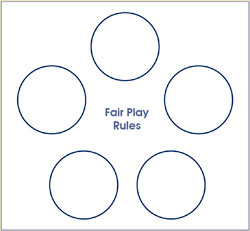|
||||||||||
|
|||||||||||
Questions/instructions:
|
|||||||||||
|
%
responses 2006 ('02) |
||||||||||
| y4 |
y8
|
||||||||||
Rules included: |
obeying rules/don’t cheat |
43 (43) |
56 (49) |
||||||||
respecting officials/coaches/listening |
9 (9) |
19 (17) |
|||||||||
helping/encouraging/being
kind/cooperate |
62 (60) |
67 (60) |
|||||||||
not being physically/verbally
rude/nasty to opponents |
53 (56) |
55 (64) |
|||||||||
accepting outcome appropriately |
15 (22) |
27 (20) |
|||||||||
giving everyone a chance |
43 (31) |
33 (29) |
|||||||||
| Overall strength of set of rules: | very strong (5 different rules) |
2 (0) |
3 (5) |
||||||||
quite strong (3-4 different rules) |
37 (38) |
49 (39) |
|||||||||
fairly weak (1-2 different rules) |
52 (52) |
44 (49) |
|||||||||
little or no understanding shown |
9 (10) |
4 (7) |
|||||||||
Total
score: |
6–8 |
9 (9) |
14 (14) |
||||||||
5 |
22 (21) |
35 (23) |
|||||||||
4 |
19 (15) |
10 (15) |
|||||||||
3 |
29 (31) |
28 (29) |
|||||||||
0–2 |
21 (24) |
13 (19) |
|||||||||
| Subgroup Analysis: |
Year 4 |
||
Year 8 |
| Commentary: |
| About half of the year 8 students and 40 percent of the year 4 students generated three or more rules judged to be good and different. There were only minor differences between the subgroups and little change between 2002 and 2006. |
|
|
